Handicraft from Kashmir
Handicrafts from Rajasthan
 |
Pure Pashmina |
| |
Pashmina Ladies of the 18th century court. In France and St. Petersburg, as well as Mughal Emperors were enchanted by the regal texture and warmth of Cashmere Pashmina. Napoleon may have started the fashion craze when he presented a Cashmere Pashmina shawl to his wife. Pashmina scarves, stoles, wraps, shawls and throws remain an essential part of a fashionable wardrobe, attesting to the durability and appeal of this classic accessory is the traditional name for the very finest grade of cashmere wool. Because of its unique softness and comforting warmth, pashmina is also known as the diamond fabric and the soft gold of high Asia. Put simply, it is the finest, softest and warmest wool available anywhere.
This amazing cashmere comes exclusively from the underbelly of the Capra Hircus goat, in the most remote regions of the Himalayas. Because they live approximately 14,000 feet above sea level, these special goats grow a thin, inner coat of hair that insulates them during the long, harsh Himalayan winters. It is this unique inner coat of hair that is used to produce pashmina. Each hair is about 1/6th the diameter of most other types of hair - but is still surprisingly durable while being stunningly soft and comforting to human skin.
You may be surprised to discover that it takes the entire annual growth of three of these goats to create just one pashmina shawl. But take comfort in the fact that these goats are not harmed during the process of producing pashmina. This is because the wool is collected only after being shed naturally. It is almost like this special cashmere wool is the goats' gift to everyone. And what an amazing gift it is!
SHAWL - 36" x 80" - 90cm x 200cm: This size is really quite big. The width (36") is about the distance from one elbow to the other if you old your arms out. the length (80") is 6feet 8 inches or the same as a really tall man. This size pashmina is great to completely wrap yourself in. It is also great to use as a handy and lightweight blanket on flights etc. It is wide enough to use part of it as a head scarf and the rest to cover your back and arms. It is a little large to wear in the noose style as a scarf, so is much better worn open.
STOLE - 27" x 80" - 70cm x 200cm: This size is the most popular and probably the most versitile. You can wear it either open as a shawl (it will cover your whole back), or as a scarf (you can still tuck it in your coat when worn in the noose style). If you are less than 5'6" tall then this might be a better option than a shawl.
LARGE SCARF - 18" x 80" - 45cm x 200cm: This size is great to wear as a scarf, or just lightly draped across the shoulders. IF you really want an accessory rather than a centrepiece, then this size will not take over your outfit. Also it folds up small enough to fit in a bag or pocket.
SMALL SCARF - 12" x 60" - 30cm x 150cm: This size is best worn as a scarf. It will fit in a pocket when folded. Good for smaller people or even children, it can add a dash of color to your outfit. |
| |

Kani Jamawar

Plain  Self Weaving - Design  Self Design  With Hand Needle Embroidery  Small Needle Embroidery  Kani Jamawar  Kani Jamawar  Kani Jamawar
|
| |
How to Make Pashmia?
Every summer, Himalayan farmers climb the mountains to comb the fine woolen undercoat from the underbelly of, himalayan mountain goat Chyangra, the Capra Hircus goat which is the source of Pashmina, lives at elevations of 14,500 feet (4,500 meters) and above, where temperatures rarely rise above minus 20 degrees Fahrenheit (minus 30 degrees centigrade) in winter. Not to be confused with the endangered Tibetan antelope, chiru that is killed to produce shatoosh shawls, some also call these Chyangra Goats as the Cashmere Goats. To survive the freezing environment at 14,000 feet altitude, it grows a unique, incredibly soft pashm, inner coat, six times finer than human hair. Because it is only 14-19 microns in diameter, it cannot be spun by machines, so the wool is hand-woven into cashmere products including shawls, scarves, wraps, throws, stoles etc. for export worldwide.
With the coming of summer, the Himalayan goats shed their warm winter coats. Their underbellies are covered with two different types of wool: the fine, soft cashmere and a coarser outer layer. The wool is gathered by local women, who comb it thoroughly to separate the from the thicker, less luxuriant wool. pashmina
| |
|
|
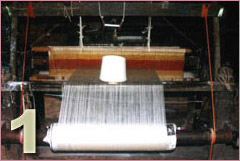 |
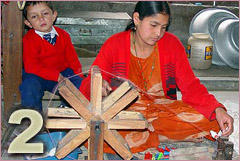 |
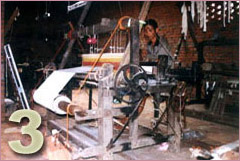 |
| Pashmina Yarn Cone and Spaun Silk in Handloom |
Preparing Pashmina Yarn for Weaving |
Weaving by The Expert Craftperson |
| |
|
|
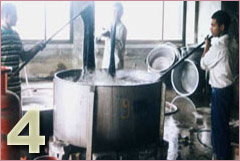 |
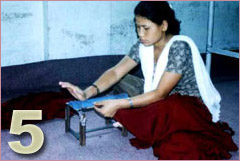 |
 |
| Dying of The Pashmina Shawls |
Making Frinqes on the edge of Pashmina Shawl |
Mending Work of Pashmina Shawl |
|
| |
How to Wash or Care for Pashmina?
We recommend Dry-clean only. However as all Pashminas as washed in our factory here But with experienced washerman. So we explain our washing instructions Pashmina are washed separately. Dip Pashmina for 15 minutes in Luke warm water say 20 degree in 10-15 litres water. Remove pashmina; again in 5-10 litre water in a bucket add 2-3 tablespoon of liquid Soap or shampoo for delicate cloth preferably for woolen clothes, Wisk up for rich leather Immerse pashmina for 30 minutes, After 30 minutes just stir it with hand politely or turn it around a few times (NO MACHINES please, otherwise 100% pashmina will shrink and get damaged, Pashmina is very delicate fiber) Rinse the pashmina in fresh running water. Rinse until water runs clear and then drip dry only DO NO WRINGLE OR TWIST or DO NOT TUMBLER DRY IT Dry in shade, away from direct sunlight; reverse if embroidered with embroidered underside. Iron it when 90% dry (not 100%). You will get the fresh pashmina though it will not be as we do. We offer you FREE one pouch of liquid shampoo recommended by ' WOOL MARK' The world trade leaders in Pashmina wool Business in the
|
| |
How to Wear Pashmina?
- Wear it as a shawl. The most common use for a pashmina is to wear it as a shawl. If you're cold or just merely want to cover up a little bit, the pashmina is perfect. Wrap it around your shoulders and secure it by either tying it in the front or allowing it to drape down.
- Use it as a scarf. Fold your pashmina up horizontally in the shape of a scarf. Tie it around your neck and allow it to dangle down.
- Use it on your wedding day. Many brides and bridesmaids are using pashminas as an extra accessory for their wedding day gowns. Usually, the pashmina will be draped over the bride's or bridesmaids' shoulder(s).
- Use it as a sarong. If you're out at the pool or just lounging around the house, you can use a pashmina as a sarong. Tie it around your waist so that it hangs off of your hips. It will resemble a half skirt. You can alter your pashmina sarong to expose as little or as much as you want to.
- Wear it as a tube top. A pashmina can double over as a tube top on those warm summer days. Fold your pashmina in half horizontally. Depending on how large your pashmina is, you might have to fold it again or fold it into thirds. Wrap it around your chest and secure it by tying it in the back.
- Wear it as a belt. This looks great over a form-fitting tank top or lengthy blouse. Fold your pashmina in half or in thirds. How you fold it depends on how big you want your belt to look. Secure your pashmina by tying it on the side of your hips.
|
|
|
|
| |
|